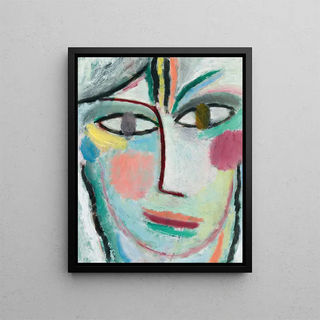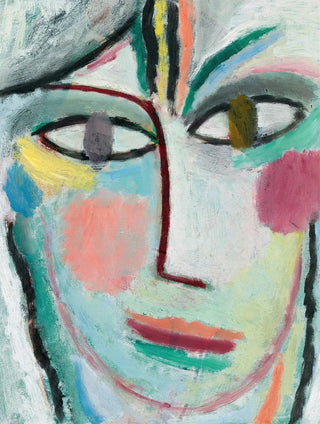Art print | Female head Femina - Alexej von Jawlensky


View from behind

Frame (optional)
In the fascinating world of modern art, certain artworks stand out for their ability to capture the very essence of humanity. The "Head of Woman Femina" by Alexej von Jawlensky is one of these iconic pieces. Through its stylized forms and vibrant colors, the artwork evokes an emotional depth that transcends a simple portrait. The depiction of the woman, both mystical and introspective, invites the viewer to explore the feminine soul, while reflecting the artistic concerns of its time. This piece, with its bold aesthetic and universal message, continues to captivate and inspire generations of art enthusiasts.
Style and uniqueness of the artwork
The "Head of Woman Femina" is distinguished by its unique style, characteristic of the Expressionist movement of which Jawlensky was a pioneer. The simplified lines and geometric shapes create an abstraction that goes beyond traditional realism. The chosen colors, often intense and contrasting, play a crucial role in conveying emotions. Each hue seems to vibrate, breathing new life into the representation of the female figure. The eyes, in particular, are strikingly expressive, capturing a gaze that appears both contemplative and filled with mystery. This stylistic approach, blending abstraction and figuration, offers a rich and complex reading of the work, allowing each viewer to project their own interpretations.
The artist and his influence
Alexej von Jawlensky, an emblematic figure of Expressionism, left a significant mark on art history with his bold vision and innovative approach. Born in Russia, he settled in Germany, where he was influenced by the avant-garde movements of his time. His encounters with other artists, such as Wassily Kandinsky and Gabriele Münter, fueled his reflection on color and form. Jawlensky sought to express deep feelings through his works, moving away from classical conventions. The impact of his work is still felt today, inspiring many contemporary artists to explore the boundaries of abstraction and emotion. The "Head of

Matte finish

View from behind

Frame (optional)
In the fascinating world of modern art, certain artworks stand out for their ability to capture the very essence of humanity. The "Head of Woman Femina" by Alexej von Jawlensky is one of these iconic pieces. Through its stylized forms and vibrant colors, the artwork evokes an emotional depth that transcends a simple portrait. The depiction of the woman, both mystical and introspective, invites the viewer to explore the feminine soul, while reflecting the artistic concerns of its time. This piece, with its bold aesthetic and universal message, continues to captivate and inspire generations of art enthusiasts.
Style and uniqueness of the artwork
The "Head of Woman Femina" is distinguished by its unique style, characteristic of the Expressionist movement of which Jawlensky was a pioneer. The simplified lines and geometric shapes create an abstraction that goes beyond traditional realism. The chosen colors, often intense and contrasting, play a crucial role in conveying emotions. Each hue seems to vibrate, breathing new life into the representation of the female figure. The eyes, in particular, are strikingly expressive, capturing a gaze that appears both contemplative and filled with mystery. This stylistic approach, blending abstraction and figuration, offers a rich and complex reading of the work, allowing each viewer to project their own interpretations.
The artist and his influence
Alexej von Jawlensky, an emblematic figure of Expressionism, left a significant mark on art history with his bold vision and innovative approach. Born in Russia, he settled in Germany, where he was influenced by the avant-garde movements of his time. His encounters with other artists, such as Wassily Kandinsky and Gabriele Münter, fueled his reflection on color and form. Jawlensky sought to express deep feelings through his works, moving away from classical conventions. The impact of his work is still felt today, inspiring many contemporary artists to explore the boundaries of abstraction and emotion. The "Head of






